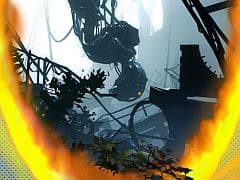Video Gamer is reader-supported. When you buy through links on our site, we may earn an affiliate commission. Prices subject to change. Learn more
So, who would have guessed that they’d be seeing Gabe Newell take to the stage of the Sony press conference this time last week? Not me, that’s for sure. About half an hour prior to Newell’s shocking announcement that Portal 2 will be heading to the PlayStation 3, and that it will be ‘the definitive console version of the game’, I was sat in a private meeting room as Valve’s Eric Johnson showed me the game in action.
Johnson began the demonstration by reminding us how important narrative was to the first game. And it was true. Portal managed to achieve something that very few games are able to do, and it did so within a remarkably short amount of time. It forced the player to care about an object in the game world (an inanimate object nonetheless), and invoked intense feelings of guilt as a result of their actions towards that object. It was nothing short of genius. With Portal 2, the same high quality of writing has returned, and the game appeared just as witty, clever and laugh-out-loud funny as its predecessor. I was falling in love all over again.
“Oh, it’s you.” chirped a familiar voice. “It’s been a long time, how have you been?” The distinct voice was of course that of GLaDOS, who – as with the first game – plays a vital role in the story. “I’ve been busy being dead, you know, after you murdered me.” This was true. At the end of the first Portal game, Chell destroyed GLaDOS with the very portal gun she bestowed upon her. Portal 2 sets GLaDOS up for her revenge mission, which spans a narrative around twice as long as the original.
The opening minutes of the new footage sees GLaDOS rebuilding the world. The familiar tiles on which portals are formed fly around new environments, creating new and exciting looking structures as they fall into place. Where the first game was incredibly clean and clinical, the world of Portal 2 is much more organic and colourful. Plants and vegetation coexist with the scientific test chambers, and the game looks far more diverse and interesting as a result.
With the scene set, Johnson went on to explain the most important addition to the game; the gameplay mechanics. First up was the Aerial Faith Plate; a kicker of sorts that launches the player into the air at tremendous speeds. Understandably, these launch pads add another layer of depth to the platforming sections of the game, mixing a bit of manual dexterity with all that puzzle solving. Next up was the Thermal Discouragement Beam, a tractor beam that can be manipulated using objects in the game world. This can be used to destroy enemies and open up new paths. Then there was the Pneumatic Diversity Vent, which blasts out powerful gusts of air, carrying the player (or any other object) into the air. Appropriate positioning of portals will affect each of these mechanics, and provide the game with the majority of its new puzzles.
In addition to these, there are new surface modifiers, which add a further twist to the usual formula. The first Portal game featured two kinds of surface: those that could support portals, and those that could not. This time around, two colourful gels change the properties of a standard surface, allowing them to be interacted with in new ways. A blue gel transforms the properties of the surface it’s painted on to that of a trampoline. It’s kind of like Valve’s answer to Flubber. The second modifier, which is orange, is known as Propulsion Gel, and allows Chell to glide across a surface at incredibly high speeds. Clever combinations of all the new mechanics make the sequel a far more diverse experience than the original game. But that’s to be expected.
What you might not have expected, was the multiplayer aspects to the game. Portal 2 will feature a separate co-operative campaign, with a completely different set of puzzles to that of the single-player. Here, two players take control of two robots, both of which can fire two portals. Those with basic numeracy skills will have worked out that this means there can be up to four portals in any given level. Johnson warned us that this meant the co-op mode would be difficult, and in order to beat the game, both players will need their thinking caps firmly on. While the co-op ‘fits into’ the narrative of the single-player, it’s self contained and doesn’t interfere with the plot of the main game.
Seeing Portal 2 in action reminded me of everything I loved about the first game. Although the demonstration was short lived, it’s clear that Valve has packed as many innovative ideas into the game as physically possible. Johnson admitted that the biggest problem facing the sequel was that it would lose the element of surprise that the first game had, but with such refined puzzling on offer even at this stage in development, I wouldn’t imagine anybody would be particularly bothered by this.
Portal 2 will be released on 360, PC, Mac, and now PlayStation 3 in 2011.
